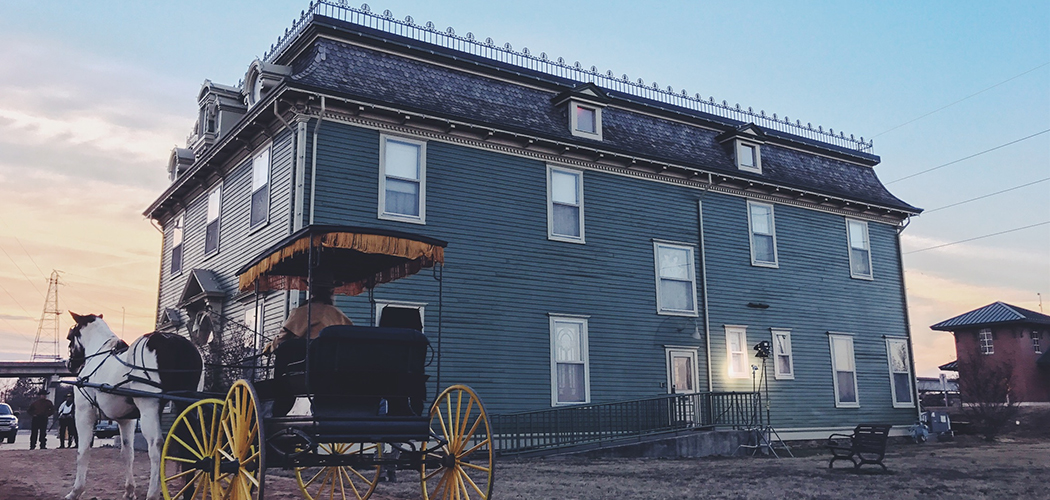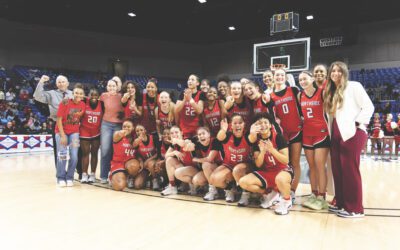[title subtitle=”words: Marla Cantrell
images: courtesy Mad Possum Pictures via: Manit Attakul (Miss Laura’s); Lane Breeden (on-set shots); Stacy Ericson (photo of Chuck King) “][/title]
Fort Smith, Arkansas was a loud frontier town at the dawn of the 1900s. Horse-drawn carriages clattered down streets. Trains pulled into the station, their brakes loud, their whistles louder. On the Arkansas River, steamboats made their way to shore, the men aboard elbowing their way off, many looking for a good time.
They didn’t have to look far; the town was filled to the gills with saloons. And while a glimpse of a woman’s delicate ankle could set a man’s heart pounding in polite society, there were other places where finding worldly pleasure was as easy as ordering a beer. Seven houses of ill-repute stood on Bordello Row near the river, all of them legal. After the sun surrendered to the moon each night, you could hear pianos playing, the deep voices of men, the high pitch of women’s laughter.
One of those houses, and undisputedly the most sophisticated, was Miss Laura’s Social Club. Miss Laura Ziegler, who always kept a six-gun nearby, charged three times as much as the other houses. Her “girls” were the prettiest around, she believed, and the most refined. She had high fences built to keep the curious from spying. She had rules that prohibited the women from being seen on the streets, in an effort, at least in part, to protect their identities. She displayed their certificates of good health, renewed each month, above their beds.
In the parlor, a player piano hammered out the tunes of the day, and liquor flowed like a well-fed stream. The house was dressed in chandeliers, in stained glass windows, and in heavy draperies where they were needed.
When Miss Laura’s girls were called down from their rooms on the second floor, they were always fully clothed, another distinction of the house. Whatever else happened took place in private.
There are stories about the upper-crust who frequented the place. There are stories that have survived about Miss Laura, her instincts about money and business and human nature, that made her the top madam in town. There are stories about the girls, where they came from, and why they’d turned to that life. One report claims many of them were from farms in the area, and once their careers ended, they married and lived quiet lives in simpler dresses.
Much fascination surrounds Miss Laura’s and its sin-stained history. Today, the building serves as Fort Smith’s Visitors Center, and tours are given regularly. From the site, you can see the churning waters of the Arkansas River; you can hear the wailing train whistles. Stand outside, and you can see all the way to Oklahoma, which was the Indian Territory when Bordello Row got its start in this border town.

Lauren Sweetser Director Devon Parks Marlane Barnes Photo by Lane Breeden
Two filmmakers found the intrigue irresistible. Chuck King and Devon Parks, from the Emmy award-winning production company, Mad Possum Pictures, started talking about the possibility of a film in 2014, just after they’d finished Step Into: The King Opera House. The docu-drama tells the story of the iconic Van Buren theater and is now shown twice a week to tourists hungry for the legends of that historic place.
They were on a creative high after filming ended. The idea of capturing Miss Laura’s showed up and stayed. Chuck, who wrote the screenplay, started doing research, adding fact upon fact, living with one foot in the present, and one in the past. He and Devon knew Miss Laura’s, just six miles away, would be the perfect second installation into their Step Into series.
Claude Legris and Carolyn Joyce with the Visitors Center talked to him extensively. The staff at the Fort Smith Museum of History offered invaluable information. Shelli Henehan and Micki Voelkel, from the University of Arkansas—Fort Smith, shared their extensive research on the house. And Joe Wasson shared the knowledge he’s gathered through countless hours of study.

Lead actress Marlane Barnes Director Devon Parks Supporting Actress Claire Bermingham By Lane Breeden (2)
What developed was a cinematic story of Miss Laura and four other women who landed at the Social Club. The story of Bertha Gale Dean had to be told since she was a protégé of Miss Laura who ascended the ranks and eventually bought the house. While Chuck wrote her lines, he could feel Bertha come to life.
“Everyone calls the house ‘Miss Laura’s,’ and it was,” Chuck says, “but Bertha, who went to work there when she was about eighteen years old, is the continuing thread throughout the history of the house.”
The other main characters are Kitty, Lanna, and Rose, whose stories are based on the history Chuck gathered. “We look at their situations and why they wound up at Miss Laura’s in Fort Smith, and what circumstances drove these young women to prostitution in order to survive.
“We wanted to give people a presentation of what life was like for these girls, starting in 1905, which was the heyday of the house, and continuing through the 1930s and ‘40s when Bertha Dean passed away.”
Even then, in the late 1940s when Bertha’s life was nearly over, the house was still operating as a brothel. The fact that prostitution was outlawed in the mid-1920s didn’t seem to concern her much.
While Chuck was busy with the script, Devon, who directed the film, was working just as hard. He’d moved from Van Buren to L.A., and knew award-winning producer/casting director, Elizabeth Barnes Keener. Elizabeth, who grew up in Fort Smith, has many casting credits including movies, and several TV shows – Beyond, Revenge, Studio 60, and Sunset Strip. She’s also a producer and casting director for the soon-to-be-released film, Parker’s Anchor, set in Arkansas.
“Elizabeth was our casting director. She brought in some Arkansas actors who are successful in L.A., and they were so willing to come back here and get this done, I think in part as a thank-you for their roots.”
When the cast was complete, it included four actors living in L.A. with deep ties to our area. Those who spent their childhoods in Fort Smith are Marlane Barnes (Twilight series) who plays Bertha; Brandon Keener (He’s Just Not That Into You) who plays Gentry; and Hunter Doohan (Mosh Opera) who plays Levi. Lauren Sweetser (Winter’s Bone) who plays Rose grew up in Fayetteville. Completing the L.A. crew was Claire Bermingham (Choosing Signs) who came to L.A. from Ireland and plays Lanna.
Two local actors were also cast. Missy Gipson, the director of Fort Smith’s Young Actors Guild, plays Miss Laura. And Hannah Lovins plays Kitty.

Chuck King Photo By Stacy Ericson
It takes a good deal of talent to write these stories so tightly that they can be told in a thirty-minute film. But Chuck was able to do that. The day after Christmas 2016, the film crew all but took over Miss Laura’s, working fourteen-hour days, and stayed through New Year’s Eve. Extras showed up to help. Local eateries brought food and coffee and water, feeding fifty people each day. Other local businesses provided whatever services were needed. “We couldn’t have done it without the community,” Chuck says.
Right now, the film is in post-production. When it’s finished, Step Into: Miss Laura’s will debut in Fort Smith, probably in late spring. Chuck and Devon hope to have it shown on AETN, the state’s public television station. But Chuck has an even greater mission. “My hope is that this film ends up being the star in the crown of Fort Smith. I think it will be part of the great buzz that’s going on in the city, and that Mad Possum will be a part of that.”
In 1905, Miss Laura’s Social Club was the Queen of the Row. Inside its walls, as the sky turned to velvet, the women waited for another night to begin. What they thought, and how they felt about the life they lived, is a mystery to us. But soon we’ll have a better idea of what they hoped and dreamed, thanks to everyone who is a part of this film.
For more on Step Into: Miss Laura’s, visit madpossum.com.
To learn more about Miss Laura’s Social Club, at 2 North B Street in downtown Fort Smith, visit fortsmith.org.




